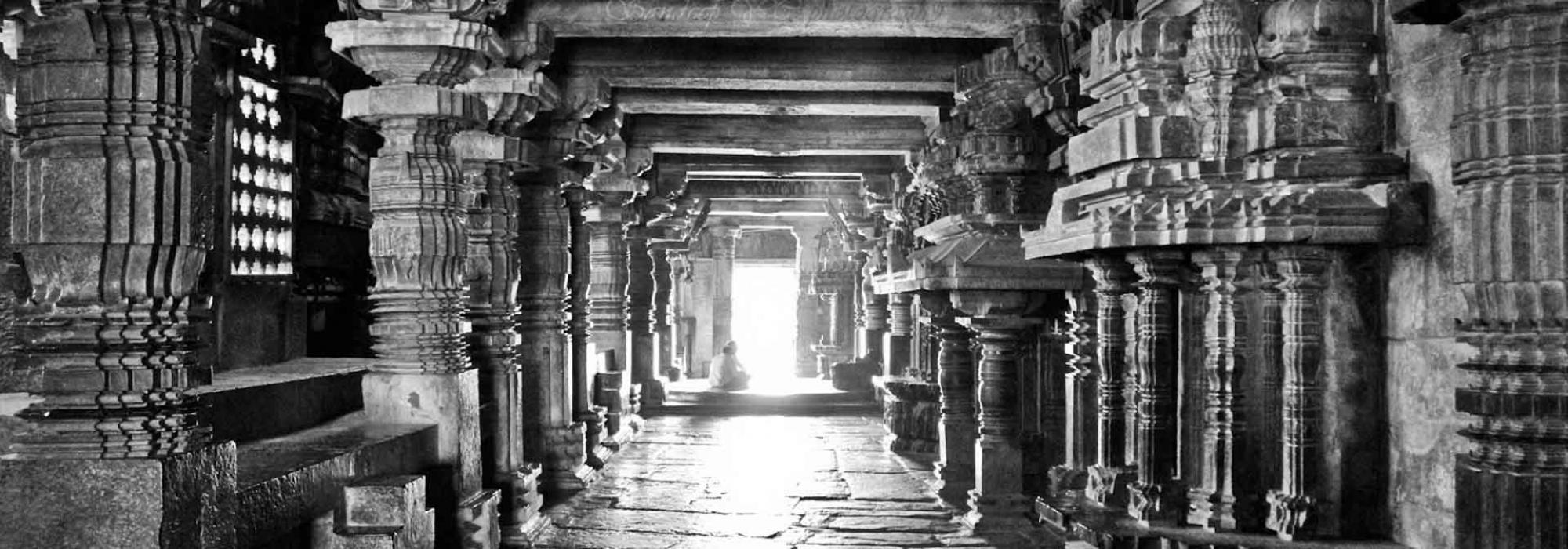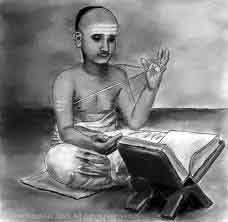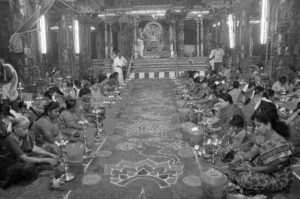My Thread Ceremony
Sri Venkatarama Bhatta urged my grandfather and my younger grandfather to perform my Thread Ceremony as early as possible.
It seems he had confided thus to my grandfather: “Chechanna, my elders taught me a few letters of the Vedas. I wanted to teach it to those born in my own lineage. But this desire wasn’t heard by God [The male children he had had, died very early. His most recent son was younger than me]. If you perform the Thread Ceremony to Mavayya early, it is my strong desire to put him on the path of Vedic study. But you are a lawyer, I’m not sure if you’ll like this proposal of mine…”
My grandfather liked it immensely. On the third day after my first anniversary of Upakarma[i] --i.e., exactly one year after completing my Thread Ceremony—Sri Venkatarama Bhatta passed a stricture. From then on, I was to sleep in the room adjoining the veranadah of my house. At about four-thirty in the morning, Sri Venkatarama Bhatta would stand outside this room and call out, “Mavayya, Gundu!” I would awake and step out of the room two or three times after this call was issued. He would hand me a small metallic pot filled with water and say, “Go, wash your face and hands and legs.” As soon as I returned and sat down, it would begin:
Sri Gurubhyo Namaha Harih Om||[ii]
After returning from the temple in the evening, he would take me to the courtyard and teach me various Stotras or hymns.
Rathnasanu sarasanam rajathadri srunga nikethanam |
Shinjinikrutha pannageswarachyuthahana sayakam ||
Kshipradhagdhapurathrayam tridivalayairabhivanditham |
Chandrashekaramasraye mama kim karishyathi vai yamah||[iii]
I seek refuge in Him, who has the moon,
Who made the mountain of jewels in to his bow,
Who resides on the mountain of silver,
Who made the serpent Vasuki as rope,
Who made Lord Vishnu as arrows,
And quickly destroyed the Three Cities,
And who is saluted by the Three Worlds,
And so what can Yama, the God of death do to me?
Combined Study
Venkataraya, the son of a family friend used to stay in our house and we used to study together. He used to join me on several occasions for Vedic lessons. If either of us sounded a wrong note while chanting, Sri Venkatarama Bhatta would say, “What’s that, Jarring Note Tiruvengadayya?” This was the harshest language that I have ever heard him speak.
A literature Vidwan named Doddabele Gopalacharya came to our town as a schoolteacher. He is the relative of Sri D L Narasimhachar, who has earned great renown as a Kannada Professor and scholar. Sri Gopalacharya translated Kalidasa’s Meghadootam and other Sanskrit poems into Kannada and published them with detailed explanations. I learned Kalidasa’s Ritusamhara under his tutelage. On occasion, he asked me:
“You have such a brilliant scholar and teacher in your town. It is extremely rare to find a Guru who teaches the Veda in this manner. Can you find out if Sri Venkatarama Bhatta will agree to teach me the Veda?”
Accordingly, I informed this matter to Sri Venkatarama Bhatta. Delighted, he exclaimed:
“Aha! I will incur a great sin if I refuse to teach the Veda to someone who is so interested to learn it. You are anyway learning it all alone. If there’s a co-learner with you, the instruction will acquire an element of beauty. Definitely, let him come.”
And so we both began the lessons with the Nakshatra Suktam.
Serving the Guru
The fourth day after my Upanayanam was the Day of Kamboli (a day where people offer Puja to the sacred pole or staff at a temple). We were busy making arrangements accordingly, preparing to leave for the Anjaneyaswamy Temple. My younger grandfather, Sheenappa draped a massive horse with the saddle and decorated it with a shawl and other embellishments and stood it in front of my house. The Vatu or the boy who had just undergone the Upanayana, had to be seated on it. This would be followed by a procession through the town. Sri Sheenappa was an ostentatious person given to extravagance. Other details regarding him are irrelevant here. Knowing his intent, Sri Venkatarama Bhatta asked him what all this was. When he heard the answer, he said in a firm tone of prohibition:
“All this is unnecessary for this occasion. This is the time for Gurupasadana (Serving and worshipping the Guru). The person who goes to a Guru’s house must be humble. Ostentation is unwarranted.”
A troupe of dancers and orchestra had assembled at the temple. Its chief, a lady approached my younger grandfather and said, “You can avail of our services en route to your home, right?” She also uttered a few harsh words on the lines of, “are we asking you money?” When my Guru Sri Venkatarama Bhatta was informed of this, he smiled and chided:
“What you say is pretty fantastic, Sheenanna. As soon as the boy is initiated into Upanayana, he takes a solemn vow of not allowing any sort of perfumes and similar luxuries near him. But you say you want to take him in the vicinity of dance and drama and women?”
Daughter’s Marriage
About two or three years after this incident, Sri Venkatarama Bhatta’s daughter’s wedding ceremony took place in his house—four days of dazzling Vedic splendour. Grand feasts, sandalwood, flowers…there was absolutely nothing lacking. On that occasion, some dance and drama artists who belonged to his vast family of disciples said that they wished to offer their services.
But they were shy and scared of proposing this directly to Sri Venkatarama Bhatta. And so they requested my father to take their proposal to Sri Bhatta and get his permission. They assumed that Sri Venkatarama Bhatta had great regard for my father’s words. My father agreed and took the proposal to Sri Bhatta. When the Majestic Vedic Guru heard the request, he said, “How’s it even possible? We are pure Vaidikas. All these celebrations are allowed for the wealthy and the Laukikas (worldly Brahmins). Out here, only those Karmas [rituals] that are prescribed by our Sastras are allowed. None of this dance and drama business for us.”
Sabha Puja
Yet another memory from that wedding has solidly stayed in my mind. There is a ritual known as the Sabha Puja[iv] the next day after the wedding. All important people of the town had gathered. About a hundred of them including businessmen, zamindars, government officials, their friends and relatives and a good number of Vaidikas.
It was around four in the afternoon. As soon as the assembly began, about seven or eight of Sri Venkatarama Bhatta’s disciples stood up. They started to shower blessings on the newly-wedded couple by chanting Vedic mantras. Each disciple held a plate filled with Mantrakshata in his left hand and some grains of the Mantrakshata in his right. But they were in a fiercely competitive mood—I need to be the first to bless them. But they waited for their Guru’s command. Sri Venkatarama Bhatta grinned and said:
“Tippayya, you tell them.”
Sri Tippa Bhatta divided them into four groups of two each, and ordered each group to chant one verse of blessing. He also assigned the sequence—which group should chant first and which next. And then it began. Of the eight, I can still clearly recall the name of one person: Suryanarayana from the Nangali village. The disciples chanted their blessing mantras in four styles—Pada, Krama, Jatha and Ghana.[v]
It was around seven in the evening by the time the Vedic chanting was over. The entire gathering were in a state of amazed trance. The faces of Sri Venkatarama Bhatta and his wife radiated immense joy. After blessing the couple, each disciple approached Sri Venkatarama Bhatta and his wife and touched both their feet. It is simply beyond words to describe the experience of looking at the sheer bliss of the Guru at that moment. It is the joy that Sri Rama felt on the day he won Lanka, it is the joy Alexander felt upon securing victory, it is the joy that Columbus experienced on the day he sighted America.
Sri Venkatarama Bhatta witnessed firsthand a Vedic Guru’s teaching coming to full fruition in his disciples.
The people of that period were unsophisticated. They weren’t even aware of the extreme niceties of being civilized. They weren’t acquainted with superlative superficiality. Not only were they simple, they believed that simplicity was the only proper way of living.
Sri Venkatarama Bhatta used to address my grandfather as “Chechanna.” He used to address my father in the singular as “Saaranna” (in Kannada, the English word "sir" is typically pronounced as "saar.") because he was a schoolteacher. Everybody used to address Sri Venkatarama Bhatta as “Appa” [Father]. His elder sisters used to address him by that moniker, which others followed.
To be continued
This is the fourth part of the English translation of the second chapter of D V Gundappa’s Jnapakachitrashaale – Vol. 5 titled "Vaidikadharma Sampradayastharu."
Notes
[i] The annual festival whereby the existing Sacred Thread is discarded and a new one is worn. It can be thought of as renewing the spiritual vow one makes to oneself.
[ii] This is the very first hymn sung to mark the beginning of any Vedic recitation.
[iii] This is the first verse of the famed Chandrashekhara Ashtakam composed by Sage Markandeya who as a young boy overcame death with the help of Lord Shiva.
[iv] Literally “Worship of a Person in an Assembly.” Typically, this involves offering respect to an important and well-regarded person of a community, village, etc.
[v] There are eleven styles of reciting the Vedas- Samhita, Pada, Krama, Jata, Maalaa, Sikha, Rekha, Dhwaja, Danda, Rathaa, Ghana. Ghana is usually considered the most difficult.
















































